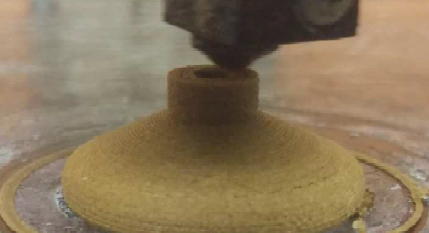Wood Furniture Waste-Based Recycled 3-D Printing Filament

|
By Michigan Tech's Open Sustainability Technology Lab.
Wanted: Students to make a distributed future with solar-powered open-source RepRap 3-D printing and recyclebot recycling. |

|
| This page is part of an international project hosted by MOST to use RepRap 3-D printing to make OSAT for sustainable development. Learn more.
Research: Open source 3-D printing of OSAT • RecycleBot • LCA of home recycling • Green Distributed Recycling • Ethical Filament • LCA of distributed manufacturing • RepRap LCA Energy and CO2 • Solar-powered RepRaps • solar powered recyclebot • Feasibility hub • Mechanical testing • Lessons learned • MOST RepRap Build Make me: Want to build a MOST RepRap? - Start here! • Delta Build Overview:MOST • Athena Build Overview • MOST metal 3-D printer • Humanitarian Crisis Response 3-D Printer |
Contents
Source
- Adam M. Pringle, Mark Rudnicki, and Joshua Pearce (2017) Wood Furniture Waste-Based Recycled 3-D Printing Filament. Forest Products Journal 2018, Vol. 68, No. 1, pp. 86-95. https://doi.org/10.13073/FPJ-D-17-00042 open access
- Full open source plans to build a recyclebot
Abstract
The Michigan furniture industry produces >150 tons/day of wood-based waste, which can be upcycled into a wood polymer composite (WPC). This study investigates the viability of using furniture waste as a feedstock for 3-D printer filament to produce furniture components. The process involves: grinding/milling board scraps made of both LDF/MDF/LDF and melamine/particleboard/paper impregnated with phenolic resins; pre-mixing wood-based powder with the biopolymer poly lactic acid (PLA), extruding twice through open-source recyclebots to fabricate homogeneous 3-D printable WPC filament, and printing with open source FFF-based 3-D printers. The results indicate there is a significant opportunity for waste-based composite WPCs to be used as 3-D printing filament.Keywords
distributed manufacturing]]; recycling; recyclebot; 3-D printing; polymer filament; wood; wood waste
Post Process
Wood Filament Suppliers
- https://www.imaginplastics.co.nz/shop/3D+Printing+Filament/Wood-Filled+PLA%3Fcat=00483.html (10% by Weight New Zealand Pine, 90 % INGEO)
- https://www.amazon.com/wood-filament/s?ie=UTF8&page=1&rh=i%3Aaps%2Ck%3Awood%20filament
- https://3dwithus.com/wood-filament
- https://woodfilament.com/
- http://www.polymaker.com/shop/polywood/ - wood like but no real wood
- https://3dprintingindustry.com/news/advanced-biocarbon-3d-develops-engineering-grade-wood-based-3d-printer-filament-146227/ - starting from poplar
See Also
- Recyclebot
- 3-D Printable Polymer Pelletizer Chopper for Fused Granular Fabrication-Based Additive Manufacturing
- RepRapable Recyclebot: Open source 3-D printable extruder for converting plastic to 3-D printing filament
- Tightening the loop on the circular economy: Coupled distributed recycling and manufacturing with recyclebot and RepRap 3-D printing
- Life cycle analysis of distributed recycling of post-consumer high density polyethylene for 3-D printing filament
- Evaluation of Potential Fair Trade Standards for an Ethical 3-D Printing Filament
- Mechanical Properties of Components Fabricated with Open-Source 3-D Printers Under Realistic Environmental Conditions
- Mechanical testing of polymer components made with the RepRap 3-D printer
- Development and feasibility of applications for the RepRap 3-D printer
- Life cycle analysis of distributed polymer recycling
- Solar powered distributed customized manufacturing
- Distributed recycling of post-consumer plastic waste in rural areas
- Ethical Filament Foundation
- Energy Payback Time of a Solar Photovoltaic Powered Waste Plastic Recyclebot System
- Economist article on U. of Washington's HDPE boat, Oprn3dp.me
- Fused Particle Fabrication 3-D Printing: Recycled Materials’ Optimization and Mechanical Properties
- Cruz, F., Lanza, S., Boudaoud, H., Hoppe, S., & Camargo, M. Polymer Recycling and Additive Manufacturing in an Open Source context: Optimization of processes and methods. http://sffsymposium.engr.utexas.edu/sites/default/files/2015/2015-127-Cruz.pdf
- Investigating Material Degradation through the Recycling of PLA in Additively Manufactured Parts http://sffsymposium.engr.utexas.edu/sites/default/files/2017/Manuscripts/InvestigatingMaterialDegradationthroughtheRec.pdf
- Mohammed, M.I., Das, A., Gomez-Kervin, E., Wilson, D. and Gibson, I., EcoPrinting: Investigating the use of 100% recycled Acrylonitrile Butadiene Styrene (ABS) for Additive Manufacturing. http://sffsymposium.engr.utexas.edu/sites/default/files/2017/Manuscripts/EcoprintingInvestigatingtheUseof100Recycle.pdf
- Kariz, M., Sernek, M., Obućina, M. and Kuzman, M.K., 2017. Effect of wood content in FDM filament on properties of 3D printed parts. Materials Today Communications. https://www.sciencedirect.com/science/article/pii/S2352492817302635
- Kaynak, B., Spoerk, M., Shirole, A., Ziegler, W. and Sapkota, J., 2018. Polypropylene/Cellulose Composites for Material Extrusion Additive Manufacturing. Macromolecular Materials and Engineering, p.1800037. https://onlinelibrary.wiley.com/doi/pdf/10.1002/mame.201800037
- O. Martikka et al., "Mechanical Properties of 3D-Printed Wood-Plastic Composites", Key Engineering Materials, Vol. 777, pp. 499-507, 2018 https://www.scientific.net/KEM.777.499
- Yang, T.C., 2018. Effect of Extrusion Temperature on the Physico-Mechanical Properties of Unidirectional Wood Fiber-Reinforced Polylactic Acid Composite (WFRPC) Components Using Fused Deposition Modeling. Polymers, 10(9), p.976.http://www.mdpi.com/2073-4360/10/9/976
Literature Reviews
- Solar powered recyclebot literature review
- Waste plastic extruder: literature review
- Life cycle analysis of polymer recycling literature review
In the media
- Kodin jäte voi pian muuttua leluiksi tai käyttöesineiksi – Tältä näyttää 3d-tulostuksen tulevaisuus, joka mullistaa muovin kierrättämisen -- Helsingin Sanomat
- Filamento de madera 3D a partir del reciclado Impresoras 3D
- Michigan Tech Researchers Recycle Wood Furniture Waste into Composite 3D Printing Material 3D Print 49.1k
- Michigan Tech Forscher recyceln Holzmöbelabfälle zu 3D-Druckmaterial aus Verbundwerkstoffen 3D Ruck
- 密歇根技术研究人员将废弃木制家具回收为复合3D打印材料 3D Imperial
- Researchers use industrial wood-waste to make FDM/FFF wood filament 3D Printing Industry 64.3k
- 美 연구팀, 폐기 목재물로 3D프린터 필라멘트 개발 성공 ZDNet (Korea)12k
- Scientists make 3D printable wood filament from furniture waste Wood Working Network 162k
- Filamento de madera 3D a partir del reciclado Impresoras 3D
- 3D printable wood filament from furniture wood-waste Wood Business Portal
- 10 Eco-Friendly 3D Printing Stories From 2018 3D Print
